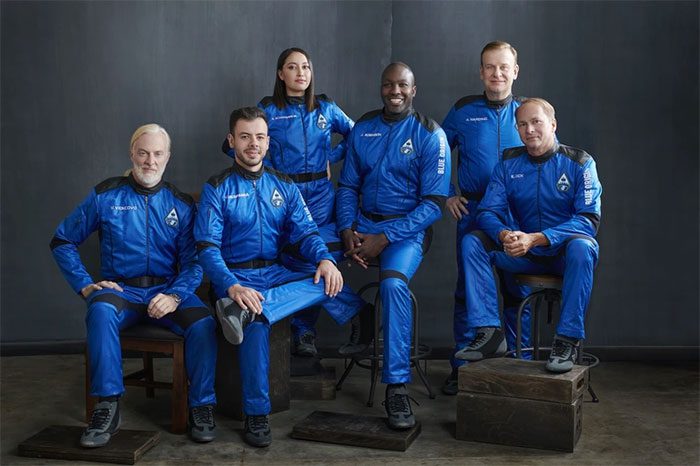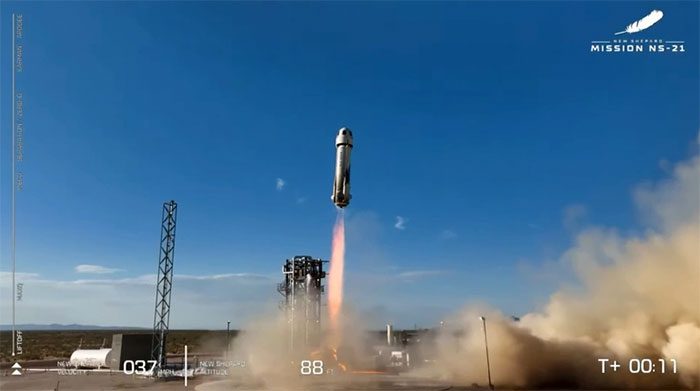The successful flight marks the 21st launch of the New Shepard rocket and the 7th spaceflight using this particular rocket.
On June 4, Blue Origin, the space company founded by billionaire Jeff Bezos, successfully completed mission NS-21, which involved sending six crew members into suborbital space (also known as Low Earth Orbit) and safely returning them to Earth.

The six crew members participating in Blue Origin’s NS-21 mission (Photo: NASA).
This is Blue Origin’s fifth crewed flight and the 21st overall flight to space for the company. The mission was initially scheduled to launch on May 20, 2022, but was postponed due to a backup system that “did not meet performance expectations.”
The six-person crew notably included Evan Dick, who previously participated in Blue Origin’s NS-19 mission, and Katya Echazarreta, a university student who became the first woman of Mexican descent and the youngest American woman to travel to space.
According to information from Blue Origin, Echazarreta’s flight was sponsored by the Space for Humanity initiative, and she was the only crew member to be compensated by Blue Origin. The remaining crew members included Hamish Harding, chairman of a private jet brokerage firm; Victor Correa Hespanha, a cryptocurrency entrepreneur from Brazil; Jason Robinson, founder of commercial real estate company JJM Investments; and Victor Bishop, co-founder of private equity investment firm Insight Equity.
To prepare for this mission, Blue Origin utilized the familiar New Shepard launch vehicle, which was fully reused from previous flights. New Shepard consists of a rocket and a crew capsule. The rocket is a single-stage vehicle, approximately 18 meters tall, powered by a BE-3 engine that burns a mixture of supercooled liquid hydrogen and liquid oxygen propellant.
At the time of launch, the six passengers donned their astronaut suits and proceeded to the launch pad, climbing into the crew capsule situated atop the rocket.

The New Shepard rocket carrying the crew into space during the approximately 10-minute flight (Photo: Blue Origin).
Subsequently, the BE-3 engine was powered to full throttle, and the clamps were released simultaneously, allowing the rocket to launch straight into the sky. It is estimated that the BE-3 engine produced around 50,000 kilograms of thrust at peak power for approximately 2 minutes and 20 seconds, propelling the spacecraft and its passengers directly into space.
Upon crossing the Karman line—an internationally recognized boundary of space—the rocket’s engine shut down automatically, allowing the crew to experience weightlessness at an altitude of about 100 kilometers for several minutes before accelerating back to Earth safely.
At the conclusion of the flight, all six crew members unanimously agreed that the most impressive aspect was the breathtaking view of Earth from space. “I can assure you that no one can imagine what it’s like until they experience it,” Katya Echazarreta stated. “Even now, just thinking about it brings tears to my eyes.”
Hamish Harding, who previously set a record for circling the globe on a jet, also expressed incredible emotions about this special flight. He exclaimed: “The entire scenery is unbelievable.”
“To see the perfect curve of the Earth, the thin layer of the atmosphere, and above all, the absolute blackness of space against the bright sunlight. Everything is right in front of you, and it truly is a once-in-a-lifetime experience.”

The successful flight opens a new future for Blue Origin in the aerospace competition.
It is reported that the entire NS-21 mission, from launch to landing, lasted only about 10 minutes. The successful flight paves the way for a new future for Blue Origin in the aerospace sector, where they seem to be leading the charge in safely taking passengers to space and back.
This flight also marks the 21st launch of the New Shepard rocket and the 7th spaceflight using this special vehicle.





















































